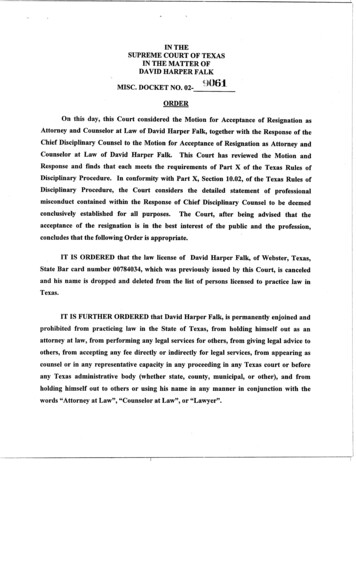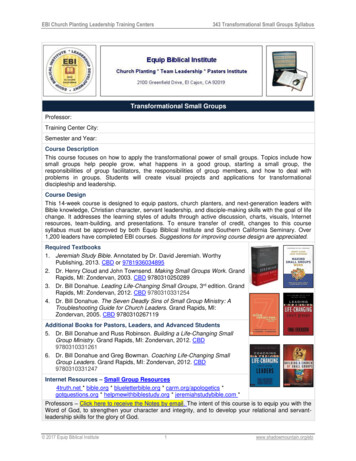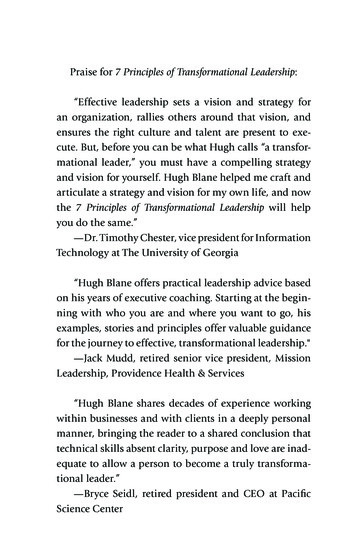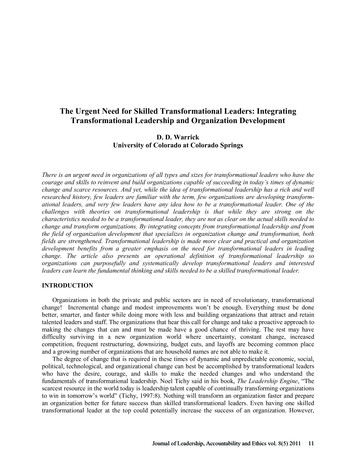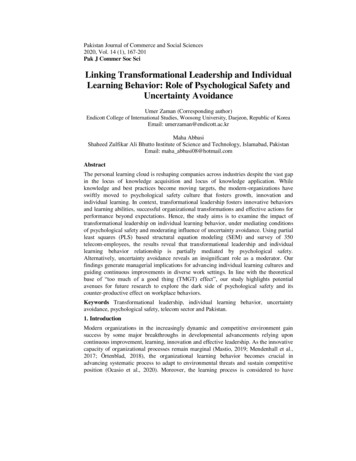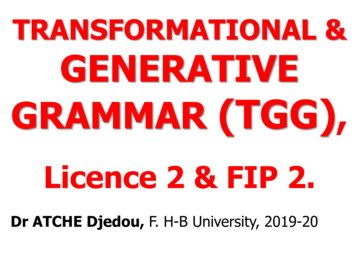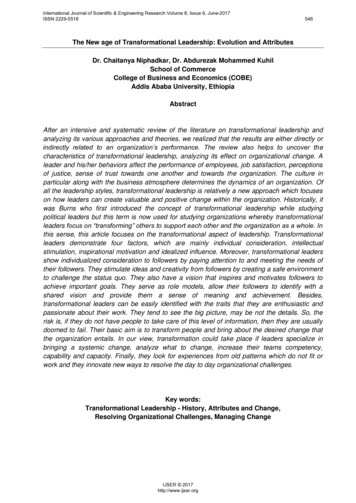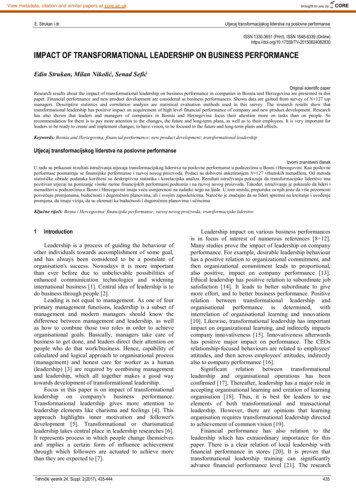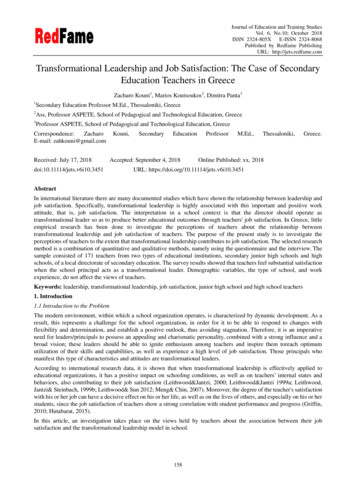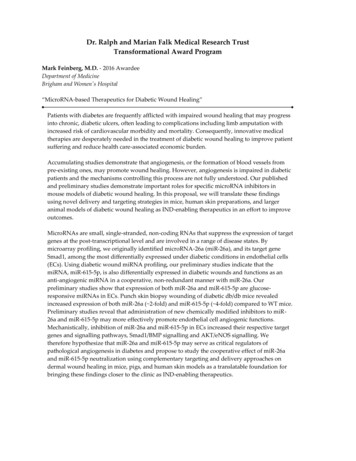
Transcription
Dr. Ralph and Marian Falk Medical Research TrustTransformational Award ProgramMark Feinberg, M.D. - 2016 AwardeeDepartment of MedicineBrigham and Women's Hospital“MicroRNA-based Therapeutics for Diabetic Wound Healing”Patients with diabetes are frequently afflicted with impaired wound healing that may progressinto chronic, diabetic ulcers, often leading to complications including limb amputation withincreased risk of cardiovascular morbidity and mortality. Consequently, innovative medicaltherapies are desperately needed in the treatment of diabetic wound healing to improve patientsuffering and reduce health care-associated economic burden.Accumulating studies demonstrate that angiogenesis, or the formation of blood vessels frompre-existing ones, may promote wound healing. However, angiogenesis is impaired in diabeticpatients and the mechanisms controlling this process are not fully understood. Our publishedand preliminary studies demonstrate important roles for specific microRNA inhibitors inmouse models of diabetic wound healing. In this proposal, we will translate these findingsusing novel delivery and targeting strategies in mice, human skin preparations, and largeranimal models of diabetic wound healing as IND-enabling therapeutics in an effort to improveoutcomes.MicroRNAs are small, single-stranded, non-coding RNAs that suppress the expression of targetgenes at the post-transcriptional level and are involved in a range of disease states. Bymicroarray profiling, we originally identified microRNA-26a (miR-26a), and its target geneSmad1, among the most differentially expressed under diabetic conditions in endothelial cells(ECs). Using diabetic wound miRNA profiling, our preliminary studies indicate that themiRNA, miR-615-5p, is also differentially expressed in diabetic wounds and functions as ananti-angiogenic miRNA in a cooperative, non-redundant manner with miR-26a. Ourpreliminary studies show that expression of both miR-26a and miR-615-5p are glucoseresponsive miRNAs in ECs. Punch skin biopsy wounding of diabetic db/db mice revealedincreased expression of both miR-26a ( 2-fold) and miR-615-5p ( 4-fold) compared to WT mice.Preliminary studies reveal that administration of new chemically modified inhibitors to miR26a and miR-615-5p may more effectively promote endothelial cell angiogenic functions.Mechanistically, inhibition of miR-26a and miR-615-5p in ECs increased their respective targetgenes and signalling pathways, Smad1/BMP signalling and AKT/eNOS signalling. Wetherefore hypothesize that miR-26a and miR-615-5p may serve as critical regulators ofpathological angiogenesis in diabetes and propose to study the cooperative effect of miR-26aand miR-615-5p neutralization using complementary targeting and delivery approaches ondermal wound healing in mice, pigs, and human skin models as a translatable foundation forbringing these findings closer to the clinic as IND-enabling therapeutics.
Michael Nishimura, Ph.D. - 2016 AwardeeDepartment of SurgeryLoyola University of Chicago“TCR Gene Modified T Autologous Cells for Treating RCC Patients”Renal cell carcinoma (RCC) is responsible for approximately 12,000 deaths every year in the US.When detected early, it is often cured surgically. However, most patients are diagnosed withadvanced disease. Despite great progress with new treatments, metastatic RCC is generallylethal. Therefore, more effective therapies are needed for patients with this disease. Recentclinical trials using T cells that are genetically modified to express T cell receptors (TCR) orchimeric antigen receptors (CAR) have shown great promise in treating cancer patients.However, this treatment can only be used for selected malignancies because of the lack oftumor reactive TCR's and CAR's. Dr. Childs at the NHLBI/NIH isolated a HERV-E reactive Tcell clone from an allogeneic stem cell transplant RCC patient. HERV-E is encoded by anendogenous defective retrovirus. While silent in normal cells, mutations in the von Hippel-Lindau (VHL) tumor suppressor gene lead to stabilization of the hypoxia-inducibletranscription factor HIF-2α which is a transcription factor leading to expression of HERV-E.Therefore, we believe that targeting HERV-E has tremendous potential to be safe and effectivefor treating RCC.Using Falk Foundation Catalyst funding, we identified, cloned, and characterized a TCR thattargets HERV-E. T cells engineered to express this HERV-E TCR were found to recognizeHERV-E RCC in cytokine release and killing assays. A high titer retroviral producer clone wasgenerated and is being GMP qualified for clinical use. Based on these results, this FalkFoundation Transformative Award application proposes to conduct a phase I clinical trial totreat 12 patients with advanced RCC. The GMP compliant T cells will be prepared at Loyola byDr. Nishimura using the Falk Foundation funding. The patients will be treated by Dr. Childs atthe NHLBI/NIH using Clinical Center resources. In addition to the proposed clinical trial, wewill clone a different HERV-E TCR which is HLA-A2 restricted. This second TCR will expandthe use of HERV-E TCR transduced T cells to more patients.
Stephen Strittmatter, M.D., Ph.D. - 2016 AwardeeCellular Neuroscience, Neurodegeneration & RepairYale School of Medicine“Therapeutic Targets to Rescue Synapse Loss in Alzheimer's Disease”Central to the pathophysiology of cognitive dysfunction in Alzheimer's disease (AD) is the lossof synapses, with an impairment of plasticity at surviving synapses. Therapeutic efforts tointervene in AD have focused on the Amyloid-beta peptide as an upstream trigger for synapticdisease, but clinical trials have been disappointing so far. Additional validated targets for ADtherapy are needed, in particular those focused more directly on synaptic deficits.One approach to target identification for AD is to study the biochemical basis for Amyloid-betaoligomer (A-beta-o) toxicity in neurons. We defined an A-beta-o --PrP-C--mGluR5--Fyn cascadethat damages synapses in AD models. In this cascade, mGluR5 is a druggable target. Here, weseek to develop specific mGluR5 agents that preserve physiological function while blockingAßo pathophysiology. A lead compound has been effective in reversing memory and synapticdeficits in mouse transgenic models during the Catalyst stage.A second approach to identify targets for AD therapy with direct clinical relevance is throughgenetic studies of Late Onset AD (LOAD) risk. The largest GWAS analysis of LOAD identifieda short list of genes whose common variants alter risk, providing potential new targets for ADtherapy. We considered whether any of these might be directly linked to synaptic dysfunctionin AD. Nearly all of the LOAD risk genes are hypothesized to bind A-beta, to alter A-betametabolism, to regulate endocytosis, or to modulate immune function. Therefore, their actionon synaptic dysfunction must be indirect. From the list of AD genetic risk factors, Pyk2 (alsoPTK2B or FAK2) is the only gene recognized to encode a protein concentrated at post-synapticdensities with direct effects on synaptic plasticity. Of note, the Pyk2 protein physicallyassociates with mGluR5 and Fyn, so its study is supported by our biochemical approach aswell. Our second goal is to develop Pyk2 inhibition as a therapy for disease modification inAD. In the catalyst stage, both genetic and pharmacological tools demonstrated the efficacy ofthis approach in mouse transgenic models.This Falk Transformational project seeks to advance the success of mGluR5 and Pyk2 agentsduring the Catalyst phase towards a full drug development program to preserve synapses inAD. We will verify disease-modifying activity, validate with additional models, examine dualbenefit for Tau pathology and provide toxicological safety information to advance these novelagents as potential disease-modifying drugs in AD.
Olufunmilayo Olopade, M.D. - 2015 AwardeeDepartment of MedicineUniversity of Chicago“Genomics, Metabolomics and Epigenetic Regulation in Breast Cancer”This application represents the output from a fully integrated team of scientists, clinicians andcommunity advocates who are committed to finding new cures for the most aggressive types ofbreast cancer by establishing a new Center for Innovation in Global Health. Global health is anarea for study, research, and practice that places a priority on improving health and achievingequity in health for all people worldwide. Breast cancer is a heterogeneous disease and themorbidity and mortality from the disease has no geographic boundaries. The basal-like breastcancer subtype is unique in its aggressive behavior and overrepresentation in young womenand women of African ancestry who have been underserved and understudied for too long.The cross-continent comparative studies that we have conducted over the past decade suggestthat both genetic factors, which are common among Africans and African Americans, andenvironmental/lifestyle factors contribute to the aggressiveness of breast cancer in bothpopulations. Our long-term goal is to reduce global disparities in breast cancer outcomes bydeveloping novel strategies for screening, early detection and treatment of basal-like breastcancer in high-risk populations. We leverage our institutional strengths in in chemistry, humangenetics, systems biology, advanced imaging and experimental therapeutics. These advantages,together with our location in the ethnically diverse south side of Chicago and our exciting newcollaborators make this a truly unique Transformative Research Program. Our overall goals arein two interrelated thematic areas with the following specific aims: 1) To personalize riskprediction for prevention and early detection of aggressive basal-like breast cancer. We willdeploy tools for cancer risk assessment within a large network of primary care providers andexamine whether population-specific polygenic risk scores can be used to stratify women intomore meaningful risk categories so that our interventions to reduce risk can be better targetedand be more effective than current standards; 2) To find novel pathways that are dysregulatedand potentially druggable in basal-like breast cancer. We will perform genome-wide geneexpression, whole genome methylation sequencing and metabolomics profiles in early and latestage breast tumors. By performing chemical screens for drugs that target metabolic pathways,we will test two compounds in vitro and in vivo as potential new treatments for the most lethalsubtype of breast cancer.The University of Chicago has a unique history of organizing around research questions andcross-disciplines, which provides a robust foundation for the transformational program.
Richard Pestell, M.D., Ph.D. - 2015 AwardeeCancer BiologyThomas Jefferson University“Targeting CCR5 In Cancer Treatment”The repurposing of FDA approved drugs may provide a more rapid path to new treatments forcancer patients. Our objective is to define the role of CCR5 in breast cancer progression andmetastasis and to carry out a biomarker-driven clinical trial using a CCR5 inhibitor for highrisk breast cancer patients. To ensure the completion of this objective we have assembled anational collaborative team of experts who have worked successfully together for many years,including the Falk Catalyst Award. For the analysis of human breast cancer molecularmechanisms of therapy resistance (Dr. Pestell, Thomas Jefferson University), for thequantitative analysis of annotated breast cancer patient samples for target protein expression(Dr. Rui, Medical College of Wisconsin), and for breast cancer circulating tumor cells (CTC) andbreast cancer clinical trials (Dr. Cristofanilli, Northwestern University).Metastasis is the primary cause of death in breast cancer patients. No treatments are directedspecifically to the metastatic process. We provide strong evidence that CCR5 is expressed inhuman breast cancer, and that CCR5 inhibitors, previously developed and FDA approved fortreatment of HIV, can effectively block breast cancer metastasis in preclinical models. Ourstudies from the current Falk Catalyst award show 50% of human breast cancer patientsexpress CCR5 in their tumor. Thus a very large number of patients are candidates for CCR5inhibitor therapy.Understanding the mechanisms of resistance to current breast cancer chemotherapeutic agentsis an urgent matter of broad importance to our patients. Breast tumor initiating cells (BTIC) areresistant to chemo- and radiation-based therapeutics. Our studies from the Falk Catalyst awarddemonstrate that CCR5 promotes BTIC formation. We show that the CCR5 cells within thebreast cancer are sufficient to drive breast cancer metastasis. Furthermore, we show CCR5induces DNA repair in breast cancer cells after chemotherapy or irradiation. CCR5 inhibitorsreduce the DNA repair response. Combination therapies aimed at reducing the DNA repairresponse selectively in tumors would be a highly favorable addition to current therapies.In order to conduct an expedited clinical trial it is advantageous to identify a marker for thetherapeutic target in the peripheral blood. During the Falk Catalyst Award we identified CCR5on the surface of patient's CTC, to identify and monitor the candidate patients for treatmentwith CCR5 inhibitors. Our proposed studies provide the rational basis for repurposing of CCR5inhibitors for CCR5 human breast cancers that are resistant to current therapies.
Menachem Shoham, Ph.D. - 2015 AwardeeDepartment of BiochemistryCase Western Reserve University School of Medicine“Novel Antivirulence Agents against MRSA and other Bacterial Pathogens”MRSA is the most widespread bacterial pathogen in the developed world. In the US, MRSAcaused 75,309 severe infections, resulting in 9,670 deaths in 2012. MRSA is resistant to mostantibiotics and strains have emerged that are even resistant to vancomycin, the antibiotic of lastresort. Thus, resistance to antibiotics and decline in the development of new antibiotics createan urgent unmet medical need to search for novel unconventional agents to prevent and treatMRSA.Antivirulence agents present an alternative or an adjuvant to antibiotics. In contrast toantibiotics, antivirulence agents are not bactericidal and not even bacteriostatic. Theirmechanism of action is based upon disarming the pathogen of toxins and virulence factorswithout killing it, thereby decreasing the pressure on the pathogen to develop resistance.During the Catalyst Award period we have developed small-molecule inhibitors of the S.aureus quorum sensing response regulator AgrA, a transcription factor that drives theexpression of a series of disease-causing toxins. Lead compounds F12 and F19 promote healingof MRSA-contaminated wounds in mice. F19 reduces bacterial load on kidneys in a murineMRSA model. Remarkably, F12 and F19 sensitize MRSA to beta-lactam and fluoroquinoloneantibiotics, to which MRSA is resistant in mono therapy. This finding opens the possibility ofreintroducing "old" antibiotics, such as penicillin, into the clinic. Preliminary toxicity studieshave established F12 and F19 safety up to 200 micromolar concentration. This data forms thebasis for the development of safe and potent novel treatment option against MRSA infections.We now propose to further develop the preclinical data package of compounds F12 and F19 invivo by exploring efficacy against an already established infection, extending the applicabilityto lung infections in wild type and cystic fibrosis mice, exploring protection of implants againstinfection in a murine MRSA graft model, and broadening the spectrum to other Gram-positivepathogens. Efficacy against Gram-negative pathogens will be explored by combination therapywith antibiotics. Possible emergence of resistance will be probed in vitro and in vivo. Medicinalchemistry will be employed to improve F12 and F19 solubility, stability and spectrum ofapplicability.Antivirulence therapy has the potential to revolutionize treatment of MRSA and other bacterialinfections.A Falk Transformational Award will enable us to generate preclinical data for an INDapplication to the FDA and subsequent clinical trials.
Stephen Strittmatter, M.D., Ph.D. - 2015 AwardeeCellular Neuroscience, Neurodegeneration & RepairYale School of Medicine“Medical Therapy To Promote Neural Repair And Functional Recovery From Spinal Cord Injury”Devastating and persistent neurological deficits occur after Spinal Cord Injury (SCI), despitesurvival of nearly all neurons. The primary cause of disability is disconnection of networks byaxon transection. Even without full-blown regeneration, studies of electrical stimulation andweight-supported training demonstrate important gains from the few surviving, but otherwisesilent, circuits in clinically complete patients. Thus, neuroplasticity and sprouting of axons areas important as regeneration per se, and medications to enhance all forms of axon growth areexpected to be strongly synergistic with stimulation and training regimens. Recovery of somemovement would be adequate for patients to gain a level of independence in wheel chairtransfers, bowel and bladder management, and locomotion. Today, there is no approvedmedical therapy for the 300,000 to 1,200,000 individuals in the USA with SCI.Our axonal growth studies included discovery of Nogo and Nogo Receptor (NgR1). Wedemonstrated their role in preventing axonal sprouting, regeneration and recovery after injury.With Falk Trust support, we have demonstrated that NgR1(310)-Fc is efficacious for recoveryfrom SCI, even when treatment starts months after damage. It is being developed for humanSCI trials with CSF administration. A small molecule therapeutic could broaden utility andreduce complications. With exciting preliminary data from the Catalyst period, we willadvance a drug-like antagonist to rodent SCI efficacy testing.While specific factors, such as NgR1, limiting axon regeneration have been identified, theyprovide an incomplete explanation for poor adult mammalian CNS regeneration. Wecompleted a genome-wide shRNA screen for endogenous genes limiting mammalian CNS axonrepair. We also conducted experiments to identify conserved genes that affect axonregeneration in the model organism C. elegans. Factors common to both systems are expectedto identify fundamental regeneration mechanisms likely to benefit human patients. We aim tostudy and develop the translational potential of such mechanisms here.One pathway is bioinformatically the most enriched gene set in the mammalian screen, andalso regulates regeneration in C. elegans. The relevance of this pathway will be tested inpreclinical models of traumatic SCI. Both gene deletion strains and pharmacological inhibitionwill be studied to provide a validated pathway for future therapeutic development. Thefindings will have high relevance for the development of novel therapeutics for SCI.
Michael Whitfield, Ph.D. - 2015 AwardeeDartmouth Scleroderma Center of ExcellenceGeisel School of Medicine at Dartmouth“Mining genomic data to identify novel therapeutics for systemic sclerosis”Autoimmune diseases have a variable presentation and progressive course. Many are difficultto treat and their root causes are elusive despite the significant health burden they imposeworldwide. Among the most difficult to treat is systemic sclerosis (SSc), a disease whosehallmark is skin fibrosis, but internal organ fibrosis and vascular disease are the main causes ofdeath. One in three patients dies within 10 years of diagnosis giving SSc the highest fatalityrate of any systemic autoimmune disease. There are no validated diagnostic markers and nocurative treatments. SSc represents a significant unmet medical need, making it an ideal targetfor the Falk Transformational Medical Research Program (FTMRP). Finding effective therapiesis critical and is the focus of this proposal.SSc progresses through multiple molecular states of inflammatory, fibroproliferative andnormal-like, that are identifiable by our recently discovered gene expression subsets. Theability to prescribe targeted therapies that modulate the underlying deregulated molecularpathway(s) in each patient is key. We have developed diagnostic strategies that identifyunderlying aberrant molecular pathways in patient skin. We have also shown that analyses ofskin gene expression provide a window into SSc internal organ disease. In our Catalyst grant,we identified the macrophage/dendritic cell axis as being a central cell type in SSc.The trigger(s) for SSc are unknown, although several studies have suggested the root causemay be immune surveillance of cancer or aberrant immune responses triggered by viral orfungal infections, within the context of a predisposing genetic background. Our hypothesis isthat SSc results from an aberrant immune response mediated in part by pro-fibroticmacrophages, triggered by an environmental stimulus.Our interdisciplinary team will address the four principal focus areas of the FTMRP byproviding insight into the basic disease process, identifying biological markers of disease andtherapeutic targets, and developing novel methods for therapeutic intervention.Our aims are:Aim 1: Develop biomarkers of disease activity and progression into a marketable diagnostictest.Aim 2: Leverage our SSc multi-tissue network to better understand the pathways modulated inSSc drug trials and the critical cell types driving disease; use the network to reposition FDAapproved drugs.Aim 4: Characterize tissue resident macrophages in SSc skin, lung and esophagus bothimmuno-phenotypically and using RNA-seq.Aim 5: Develop a strategy to therapeutically target alternatively activated profibroticmacrophages using CAR-T cell technology and / or bi-specific antibodies.
Dr. Ralph and Marian Falk Medical Research Trust Transformational Award Program Mark Feinberg, M.D. - 2016 Awardee Department of Medicine Brigham and Women's Hospital "MicroRNA-based Therapeutics for Diabetic Wound Healing" Patients with diabetes are frequently afflicted with impaired wound healing that may progress
